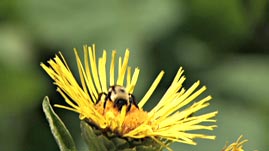Teachers' Domain - Digital Media for the Classroom and Professional Development
User: Preview

Source: A Navajo Technical College production for NASA's Where Words Touch the Earth



In this video segment adapted from Navajo Technical College, hear personal observations about how the environment—plant life, in particular—has changed in the Navajo Nation. One Elder describes how the environment used to be in balance, and there was an abundance of vegetation and corn, but now she believes the environment is decaying. A professor of environmental science describes how when he was a child, there seemed to be more of a monsoon season, the vegetation was more lush, and some native plants were easier to find.
A common misconception is that the term "monsoon" refers to a single intense storm; in fact, the term refers to a seasonal wind shift. A monsoon is a seasonal weather pattern that causes heavy rainfall and thunderstorms. The North American monsoon (also known as the Mexican monsoon or Arizona monsoon) causes a summer rainy season in the southwestern United States and northwestern Mexico. It is not as strong as monsoon systems found in other parts of the world, but it is significant and affects the weather over a large part of North America. Most areas in the southwestern U.S. receive about half of their annual precipitation from the monsoon.
The monsoon weather pattern typically begins to develop in late May and early June. Intense solar heating leads to the wind shift that produces a change in moisture conditions. As the land warms faster than the ocean, an area of low pressure is created over the land. The wind pattern shifts to bring moisture from the eastern Pacific Ocean, the Gulf of California, and the Gulf of Mexico into the typically dry land areas. When the warm, moist air gets lifted (by mountains, for example), the air cools, condenses, and produces rain. During the monsoon, there are periods of heavy rain and thunderstorms (called bursts) as well as periods with little or no rain (called breaks). In Arizona and New Mexico, the monsoon rains usually arrive in July and last until mid-September.
The monsoon is a vital source of precipitation for the region. The rains play a major role in sustaining native vegetation and agricultural crops, as well as replenishing water supplies. However, the intensity and frequency of storms can vary a great deal. Different areas, even within a city, can experience very different conditions. The monsoon is also hard to predict—there are many factors that affect it, including sea-surface temperature, large-scale weather patterns, and land-surface conditions. The monsoon changes from year to year, and forecasting monsoon activity is difficult.
How will global climate change impact the North American monsoon? Researchers are still unsure. The global climate models (GCMs) used by scientists to develop future climate scenarios are not of sufficiently fine spatial and temporal resolution to accurately describe the North American monsoon. More research will be necessary to answer this question.
As seen in the video, personal observations clearly indicate that there have been changes in the plant life in the Navajo Nation. A change in vegetation can be explained by a change in the available moisture. However, the amount of moisture is affected by both the amount of precipitation and the temperature, so it's likely that both changes in precipitation and temperature need to be taken into account.
 Loading Standards
Loading Standards